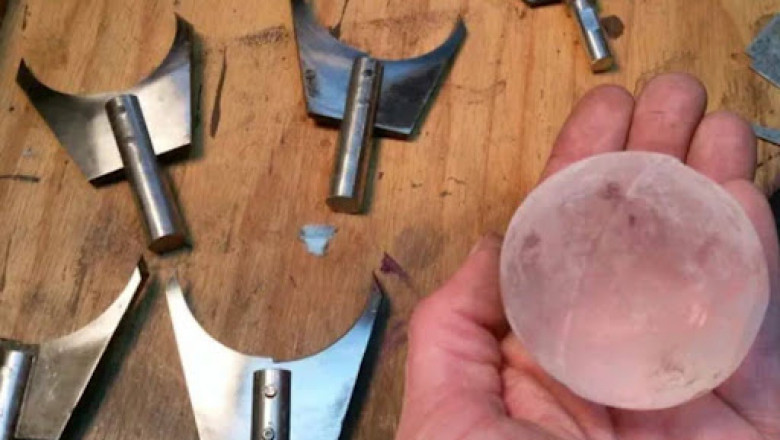views
Ice carving is a delicate art that requires skill, precision, and the right tools. Whether you’re a professional ice sculptor or a hobbyist, using the correct ice carving tools for each stage of your project can make a huge difference in the quality of the sculpture. In this guide, we’ll explore different ice carving tools, specifically focusing on the various shapes and their uses. From ice sculpting tools to power carving tools, understanding the distinct shapes of ice carving tools will help you achieve the desired results in your creations.
Ball Nose Ice Carving Tool
The ball-nose ice carving tool is often used for creating rounded shapes and fine details. This tool has a semi-spherical tip that allows for smooth carving, ideal for shaping the curves of a sculpture. It is often used in both the initial roughing stages and the finer detailing stages of ice carving. The ball nose tool is perfect for adding gentle curves, smoothing surfaces, and creating shallow indentations. It is commonly used when sculpting softer areas of ice or when an artist wants to create intricate, flowing patterns.
Some common applications of the ball nose tool include carving delicate facial features, intricate designs on an ice sculpture, or smooth, rounded edges on abstract art. Its ability to create smooth and rounded forms makes it a versatile and essential tool in any ice sculptor’s toolkit.
Cylinder Ice Carving Tool
The cylinder ice carving tool features a cylindrical blade that is excellent for shaping straight edges and flat surfaces. This tool is commonly used in the initial stages of ice carving to remove large blocks of ice and shape them into more manageable forms. The cylindrical shape allows the sculptor to control the depth and width of cuts, making it ideal for working with large, flat areas of ice.
Cylinder tools are typically used when precision and straight lines are required. It also works well with power carving tools for fast, smooth cuts, especially on large sculptures where speed and accuracy matter.
Flame Ice Carving Tool
The flame ice carving tool features a pointed tip that resembles the shape of a flame. This tool is used for creating sharp lines, details, and fine features within an ice sculpture. The flame-shaped tip allows for both precision and control when carving small, intricate details, such as the contours of a face, hairlines, or delicate patterns in the ice.
This tool is especially effective when working with intricate, small-scale features, and its pointed end can be used to create deep cuts or fine lines. Artists often turn to the flame ice carving tool when working on fine details like eyelashes, veins, or textured elements of a sculpture. It is also useful for shaping ice surfaces and adding depth to the sculpture with light, controlled strokes.
Sphere Ice Carving Tool
The sphere ice carving tool has a rounded tip designed for creating spherical shapes or hollowed-out areas. Its round shape is ideal for carving out spherical features or adding volume to a design. Sculptors use the sphere tool to create curves or to round off sharp edges, which is essential for achieving smooth and polished surfaces.
One of the most common uses for the sphere tool is to carve out eyes, round shapes, or circular features in sculptures. Artists also use this tool to remove excess material and smooth the surface when creating organic forms such as flowers, fruit, or round objects. It’s also helpful for sculpting decorative elements that require a soft, rounded shape.
Taper Ice Carving Tool
The taper ice carving tool is unique due to its tapered shape, which allows for both fine detailing and larger cuts. The tool gradually narrows from the base to the tip, making it versatile for creating both wide and narrow cuts. The tapered shape is perfect for removing larger chunks of ice while also offering the flexibility to create more delicate details when needed.
Taper tools are commonly used in the mid-stages of carving, where the sculptor is starting to refine the shape of the ice. They are ideal for creating angled cuts, detailed lines, and adding precision to specific parts of the sculpture. Artists often use the taper tool when working with angular, sharp details or carving the outlines of objects.
In addition to these basic tools, there are specialized ice sculpture carving tools designed for specific tasks. These tools can range from chisels and knives for finer detail work to power carving tools that help break down large blocks of ice more quickly.
Conclusion
Understanding the different shapes and uses of ice carving tools is key to creating beautiful and intricate ice sculptures. From the rounded precision of the ball nose tool to the straight cuts of the cylinder tool, each type of tool serves a specific function in the carving process. By choosing the right tool, ice sculpting tools, sculptors can bring their creative visions to life with greater ease and precision.














Comments
0 comment